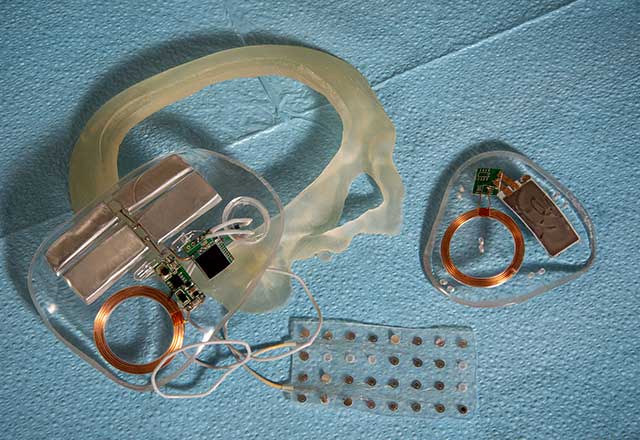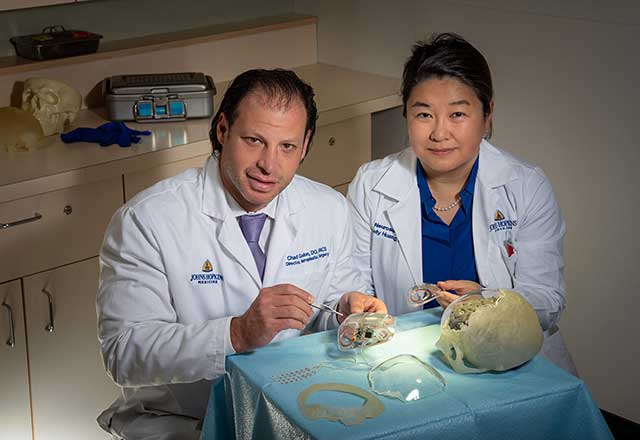About Neuroplastic Surgery
 Johns Hopkins clinicians created these neuroplastic devices to house neurologic implants and maintain skull shape for neurosurgical patients.
Johns Hopkins clinicians created these neuroplastic devices to house neurologic implants and maintain skull shape for neurosurgical patients.Thanks to surgical advancements, new technologies and biomaterials, the fields of neurosurgery and plastic surgery can now combine their surgical approaches and state-of-the-art materials to improve outcomes for patients who need cranioplasty.
Complication rates can be high for patients who need complex scalp and skull reconstruction/closure due to surgery for brain tumors, hydrocephalus, epilepsy, traumatic brain injury or neurofibromatosis. A neuroplastic surgical approach can minimize these complications by providing solutions for:
- Durable scalp closure
- Reduced infection of cranioplasty material
- Reduced risk of stroke, hemorrhage or seizure during the surgery
- Retained facial appearance without visual deformity and the attached social stigma
What You Need to Know About Neuroplastic Surgery
Johns Hopkins neuroplastic surgeon Chad Gordon describes how patients who need brain surgery can benefit from neuroplastic surgery, a new field that combines the expertise of neurosurgery with plastic and reconstructive surgery to preserve or restore a patient’s appearance.
How Neuroplastic Surgery Developed As a Field
In the mid-20th century, we learned that breast cancer outcomes could be dramatically improved by establishing a unified approach to address the cancer while retaining breast form and function, rather than just removing the disease. Now, over 50 years later, neuroplastic surgery is accomplishing similar effects for face and skull reconstruction for patients battling brain disease and requiring cranial neurosurgery. The neuroplastic surgery team at Johns Hopkins, led by Dr. Chad Gordon, has developed numerous new strategies to optimize patient-centered care for these patients.
Under Dr. Gordon’s vision, the evolution of this new specialty began at Johns Hopkins, and the first center for neuroplastic and reconstructive surgery was created through a formal collaboration between the Department of Plastic and Reconstructive Surgery and the Department of Neurosurgery. Dr. Gordon formed a multidisciplinary team of physicians, scientists and engineers with a goal to develop techniques and devices to treat adult neurosurgical patients. These advances led to several “first-in-human” publications and skull implant/craniofacial computer-assisted technology patents, and allowed for establishment of the first formal neuroplastic and reconstructive surgery fellowship training program.


